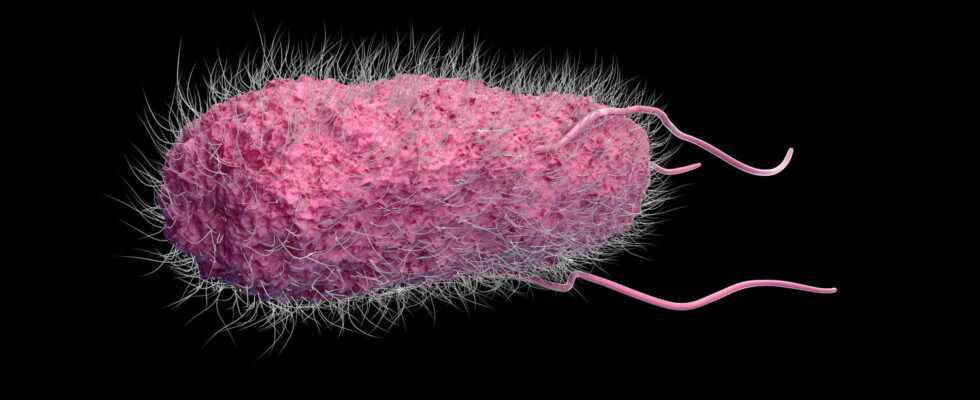“Salmonella Typhimurium” is a salmonella that can cause gastrointestinal disorders and fever. It was she who was found in the Ferrero factory where Kinder withdrawn from the market are produced. What is this bacteria? Symptoms ? Treatments ?
[Mis à jour le 8 avril 2022 à 15h30] Following investigations carried out by the Belgian and French health authorities, in particularthe Ferrero company, which markets chocolates from the Kinder range, has recalled several products due to suspected infection Salmonella Typhimuriuma type of bacteria that can potentially cause salmonellosis. The route of transmission is digestive. Salmonella is able to survive for a long period (years) in a dry environment. She may be found in products with low water activity (milk powders including infant formulas, dried fruits, chocolate, cereals, spices, etc.), indicates the National Agency for Food, Environmental and Occupational Health Safety (handles). What is this bacteria? What symptoms do they cause? What treatment to treat an infection?
What is Salmonella Typhimurium?
The Salmonella or “salmonella” is a genus of gram-negative bacilli belonging to the family of enterobacteriaceae. To date, more than 2500 different serotypes (or serovars). With 2,500 contaminations per year, the Salmonella Typhimurium would be the third salmonella causing the most poisoning in France. According to the National Agency for Food, Environmental and Occupational Health and Safety (ANSES), this type of salmonella emanate most of the time from the digestive tracts of pigs. Problem: the majority of these pigs being healthy carriers (i.e. they can transmit the bacterium to others without being sick themselves and showing no symptoms), the bacterium would therefore be very difficult to detect and bacterial foci, which are almost impossible for breeders to identify. For example ,”these salmonellae can spread in farms if the buildings are not well cleaned. At the time of slaughter, it is necessary, among other things, to ensure that the digestive tract of the animal is not in contact with the muscle and that salmonella are not conveyed by insufficiently disinfected knives.“, specifies Vincent Leclerc, epidemiological project manager at ANSES.
What are the symptoms of Salmonella Typhimurium?
This strain of salmonella called “Salmonella Thyphimurium” causes gastroenteritis which is manifested by:
- diarrhea,
- vomitings
- abdominal pain or cramps
- fever
- sometimes even sepsis, a serious infection that spreads in the
organism through blood).
Symptoms appear from 6 to 72 hours (usually 12-36 hours) after Salmonella ingestion, and the condition lasts 2-7 days. Most cases of salmonellosis are mild, but sometimes the disease is life-threatening. The seriousness of the affection depends in particular on factors related to the host, insists theWHO. The disease can be particularly serious in the youngest, the elderly and patients whose immune defenses are weakened.
In which products is Salmonella Typhimurium generally found?
This bacterium identified in the pig sector, would have spread to the bovine sector
In general, the Salmonella Typhimurium bacterium is found in charcuterie and pork-based charcuterie derivatives like the sausages, rillettes or hams. Moreover, this bacterium, identified in the pig sector, would have spread to the beef industry, explains an epidemiologist from Public Health France. And to add that “manufacturers must continue their work to limit the risks from farm to fork“. It can therefore also end up in products made from eggs or milk. Data from National Reference Center for Salmonella at the Institut Pasteurindicated that in ten years, the number of people infected with salmonella called Thyphimurium had been multiplied by 50.
What is the serotype of this salmonella?
The serotype of a bacterium is the set of characteristics of certain micro-organisms making it possible to differentiate between strains belonging to the same species. The serotype of this Salmonella is Typhimurium.
Salmonella are found in most domestic and wild animals and are present in food animals such as poultry, pigs and cattle. Salmonella can therefore pass throughout the food chain, from food for animals, in primary production and up the whole chain to households, catering services and institutions. Humans usually contract salmonellosis by consuming contaminated food of animal origin (such as eggs, meat, poultry and milk), although other foodstuffs, such as manure-contaminated green vegetables, may be implicated in transmission.
What is the treatment for Salmonella Typhimurium infection?
Routine antibiotics are not recommended for mild or moderate forms in otherwise healthy individuals.
According to the National Institute for Research and Security (INRS)), the treatment of this infection initially involves treating the symptoms with a supply of electrolytes (to replace for example sodium, potassium and chloride ions, lost following vomiting and diarrhoea) and rehydration. Routine antibiotic use is not recommended for mild or moderate forms in otherwise healthy subjects. The introduction of antibiotic therapy is considered in severe formsparticularly in groups at health risk such as infants, the elderly and immunocompromised patients. No vaccine exists.
If zero risk does not exist, a few simple actions can limit the risk of contamination:
- respect the cold chain by ensuring that meat products are not left at room temperature for an extended period;
- maintain a temperature in the refrigerator around 4°C and clean it regularly;
- wash your hands thoroughly, as well as the work surface, cutting boards and kitchen utensils, before handling poultry, cold cuts or beef;
- avoid putting cooked meats back on the plates or dishes where they were placed raw;
- thoroughly cook sensitive foods such as poultry, minced meat and meat products;
- people at risk in whom the infection may be more severe, such as children, the elderly or pregnant women, should avoid consuming cold cuts. In case of suspicion or intoxication, inform your doctor immediately.
| Good to know : the best protection against the risk of salmonellosis is good cooking of food, especially meat, at least 65°C for 5 to 6 minutes, advises the Institut Pasteur. |
Sources: WHO / Pastor Institute / Ministry of Economy / INRS website
